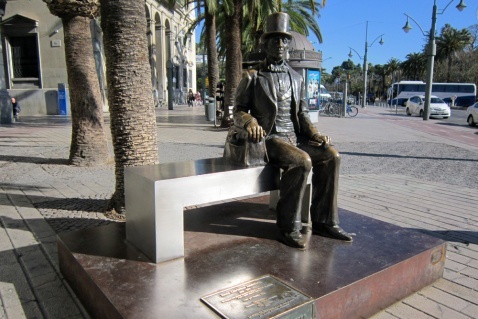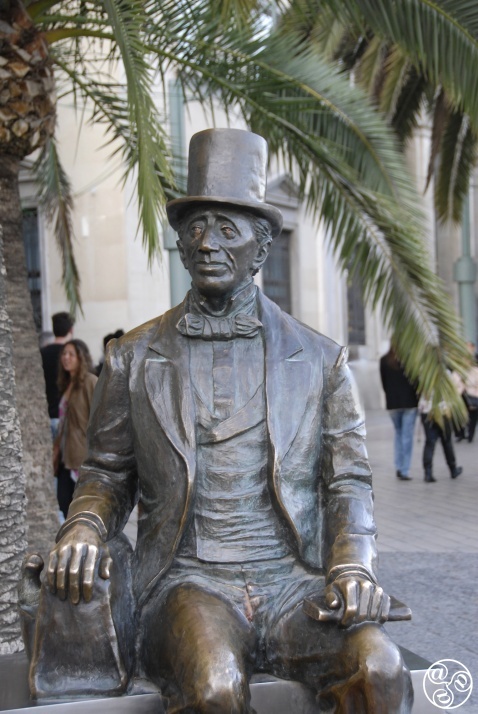
Statue of Hans Cristian Andersen, Plaza de la Marina, Malaga ©Andrew Edwards |
|
Hans Cristian Andersen, WRITER (1805 - 1875)
by Andrew and Suzanne Edwards
Hans Christian Andersen is perhaps a surprising figure to be associated with Andalucía. Known as a poet, playwright and novelist, he is most synonymous with the fairy tales he penned, many of which, although having universal appeal, display a very Nordic character. Countless childhoods have been filled with stories of 'The Snow Queen', 'The Tinderbox' or 'The Ice-Maiden' and his works continue to attract new readers. What is less known outside Scandinavia is his abundant output as a travel writer or the fact that he often ventured out from his native Denmark to explore much further afield.
Andersen was a complex character, tall, gangly and plain-looking, he could be said to have resembled the Ugly Duckling of his own story. He lost his father as a child and only received a basic early education. At the age of 14 he tried to make it on the stage in Copenhagen, but when his one asset changed, his soprano voice breaking, Hans Christian turned to writing. Jonas Collin, the National Theatre Director, recognised his talent and sent him back to school where he was the out-of-place older boy. Eventually, he became the protégé of some rich patrons and was able to work his way up the social and cultural ladder using his innate talent to its fullest.
When able to travel, Andersen took maximum advantage of the time and explored the locations he wanted to visit, which included a trip to England and an encounter with Charles Dickens. Among his travelogues there are books about Italy, a popular destination for Scandinavians; portraits of Sweden, Saxony and the Harz mountains; not to mention 'A Poet's Bazaar', his journey to Greece, Turkey and up the Danube. But it was Andalucía, in particular Málaga, that captured his heart. The translated account of his Spanish travels, published as 'In Spain', was released to its English speaking audience in 1870, some 7 years after the original.
As with all of Andersen's very readable travelogues, he spiced the description with comment, asides and even poetry. He arrived in Málaga by boat in October 1862 as part of a Spanish tour and was happy to find many Danish ships in the harbour, something he considered a good omen. He stayed in the Fonda del Oriente which looked out over the Alameda, affording him a view of street life and the sea. He paints us a vivid picture of that first night: 'The stars were beginning to shine, the crowd increased beneath; the promenaders went under the trees on the level ground; riders and persons driving kept the paved road. A band of musicians were playing airs from "Norma"; my thoughts turned into verse, on the sweet southern evening'.
The following days were spent wandering the streets, soaking up the atmosphere. On one occasion, lost in a reverie about the city's Moorish past, Hans Christian was awoken by its bustling present: 'I heard in the street the sound of castanets. Under the shadow of a house sat a young, pretty Gitana, selling chestnuts; there came peasants with baskets full of figs and dates; heavy bunches of ripe grapes lay above each other amidst the pretty brownish-red vine leaves...'. He was assailed by the sights, smells and sounds of southern Spain, a far-cry from the cold wet flatlands of Denmark. It is Andersen's enquiring mind and lively prose that stop him falling into that northern European stereotype - the smitten Mediterraneophile.
He was very struck by the market in the dry river bed, a channel that is today concreted over and regulated. In Hans Christian's time it was liable to flood, sweeping away all before it - market traders, cattle, everything. He was moved to write a poem conjuring up a biblical deluge: 'On a sudden the scene is changed, / And O what torrents of rain! / Roaring streams from the mountains flow, / And every defense is in vain. / All fly - while the river's bed / With the rushing flood o'erflows: / Its raging, wanton course...'. With Collin, his travelling companion, Andersen was driven up through the parched bed to the villa of a local merchant, where the garden was flourishing splendidly. No doubt a perilous location for a property, but built with a human's propensity for finding the fertile in areas fraught with natural danger.
Although Hans Christian was a confirmed bachelor, locked into his own solitary emotional life, he had feelings for both sexes and was clearly swayed by 'Andalusian eyes', which he whimsically deemed 'Satan's work' - 'Where is my muse? My passport, where? / How shall I defended be / Against Spain's luring sirens fair? / I feel the Inquisition has me!' The Alameda proved the best spot in Málaga for people watching as, coupled with the Paseo del Parque, it continues to be to this day. Additionally, there was always the bullfight, a spectacle that both appalled and fascinated the aesthetic Dane.
He also found himself caught up in preparations for a royal visit. The city's lopsided cathedral was being hung with lamps, and temporary fountains were being erected that were attached to tin tubes hanging from the trees. Water would be directed along these conduits to activate the fountains as the regal cavalcade swept by. The entrances to key streets had imitation triumphal arches and the harbour was adorned with what he described as an 'airy, fluttering Moorish hall' made of canvas and wooden laths. The money spent must have been enormous and probably caused some resentment in certain quarters. Andersen steered away from any political comment, a mantra he makes very clear when talking of his fellow German guests at the Fonda: 'Not a word was said of politics - that jarring subject was not brought forward'.
He most enjoyed the art of strolling, delighting in the little nooks and crannies that he discovered, particularly if they had a faint trace of the Moors. Some of his fairy tales were inspired by the Arabian 1001 Nights and he must have loved stumbling upon remnants that could have leapt from his pages - ' Not far off, in a crooked, narrow street, still remain a couple of old Moorish houses, with whitewashed walls; part of the whitewash, portions here and there have peeled off, revealing marble pillars'. The pillars sound like the start of a fable that he sadly never wrote.
Taken as a whole, his account of Málaga displays the tonic effect the city had on his sense of wellbeing, whether 'in company with new friends, or alone by one's self, a stranger amidst a busy crowd, one always feels in a humor to be pleased, to enjoy everything as youth does, to have one's thoughts filled with gladness and song'. He even tried to unshackle 'a thousand insipid ingrafted prejudices', a feat singularly not managed by many English travel writers of the period. Perhaps his most renowned and oft repeated quote about his stay is now etched into the base of the bronze statue by José María Córdoba comissioned by the Danish Royal house and located in the Plaza de la Marina: 'In none of the Spanish towns have I been so happy, so entirely at home, as here in Malaga'.
Andrew and Suzanne Edwards have written Andalucia - A Literary Guide for Travellers, published in September 2016 by I. B.Tauris. It may be purchased from Amazon. This compliments their previous work, Sicily: A Literary Guide for Travellers (Literary Guides for Travellers)
Hans Cristian Andersen also visited and wrote about the English Cemetry in Malaga.
Hans Cristian Andersen (2nd April 1805, Odense, Denmark - 4th August 1875 Rolighed)
Fonda del Oriente
The Fonda del Oriente (and Fonda de Alhameda) were the first real hotels in Malaga as they offered a quality service to travelers rather than just a place to sleep and eat. They opened about 1845 and were both the initiative of young foreigners. The Fonda de Oriente was initially located at Alhameda 11 and was run by the Swiss Carlos Brunetti and the Frenchman Francés Pedro Gassend with four employees. Some years later after Carlo left (to run the Fonda de Alhameda) it moved to Alhameda 8, a building that had been occupied by the Comandancia de Marina. The 1861 "Benito Vila Guide" noted that the Fonda de Alhameda was also known locally as the Fonda de Inglés due to the large number of English who liked to winter there. Perhaps this is why Andersen stayed a the Orient in October 1862. The Fonda de Orient closed in 1878 whilst the Fonda de Alhameda grew and in 1890 was purchased by Yotti Company, reformed and became the Gran Hotel de Roma.
Books by Hans Cristian Andersen
Buy your copy of - Andalucia - A Literary Guide for Travellers
 Andalucia - A Literary Guide for Travellers
Andalucia - A Literary Guide for Travellers
Andalucia is the quintessence of Spain and yet, historically and culturally, it is surprisingly unlike the rest of the country. Its literary history began to develop with the Romans and reached an early flowering when Arabic poets drew on centuries of literary tradition, together with the landscapes and passions of Moorish Spain. Later, Prosper Mérimée, Byron and Washington Irving forged legends of exotic southern Spain that persist to this day and Spanish writers themselves captured the rich tapestry of Andalucian culture, from Cervantes’ Seville to the Córdoba of Baroque poet Luis de Góngora and Lorca’s ‘hidden Andalucia’. With the advent of the Civil War, a new generation flocked to Andalucia and were inspired to write some of the twentieth century’s most iconic works of literature, from Hemingway’s For Whom the Bell Tolls to Gerald Brenan’s The Spanish Labyrinth and Laurie Lee’s trilogy of books. As vibrant and compelling as the region itself, Andalucia: A Literary Guide for Travellers illuminates the very soul of Spain.
